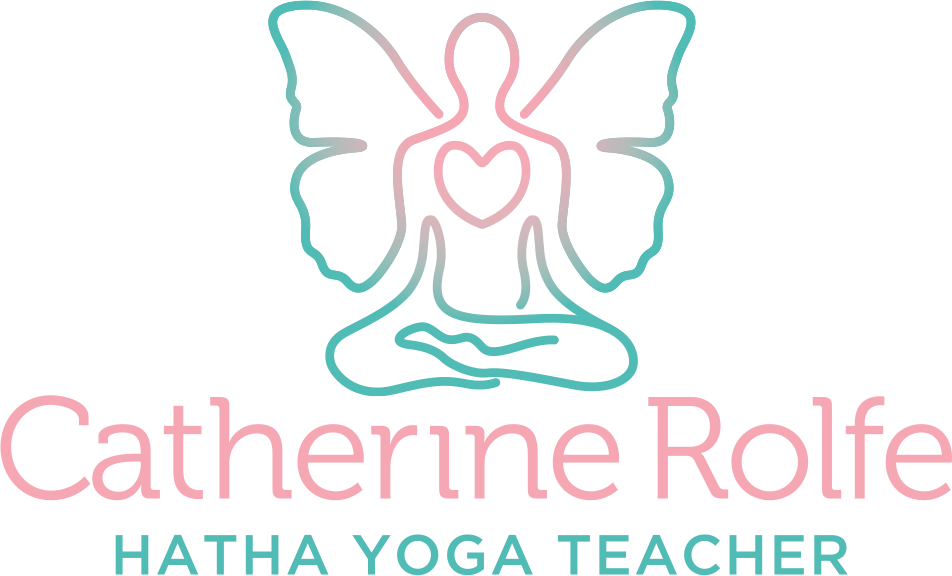We all know how great we feel after that long Yoga class – refreshed, relaxed, restored – but how can we get more of that feeling into our everyday lives? Since the arrival of my son at the end of October, there has been little opportunity for long periods of practice on my mat and I’ve found out how easy it can be to tell yourself, ‘I just don’t have the time for self-care.’ For moments like this, when you feel there’s no time to stop, I think this quote from Anthony de Mello says it all:
‘There was an exhausted woodcutter who kept wasting time and energy chopping wood with a blunt axe because he did not have the time, he said, to stop and sharpen the blade.’
The time you take for yourself, ‘to stop and sharpen the blade’, can be so transformative. However, even once you recognise the need for self-care, there’s working out what that will look like for you – the what, when and how of it. For me, it’s Yoga, nourishing my mind, body and soul, but with a new life in the house to take care of, the nature of my practice has had to evolve. I consider this one of the many gifts my little one has already given me – the ability to be increasingly creative about how I can weave my practice into my day (they say necessity is the mother of invention)!
Fortunately, I already knew about the power of a ‘minimum effective dose’ of mindfulness – see the great Tiny Pause site for some more on this – and then a read of the incredibly inspiring and practical Dr Rangan Chatterjee’s Feel Better in 5 did the rest in explaining how seemingly small actions really do add up, as well as providing tips on building these actions into daily habits.
The result? I’ve found seven short yet powerful practices that really transform my outlook, energy and sense of peace. By committing to practicing them daily, I have realised it is possible to get a dose of the well-being boost I was used to getting from long sessions on my mat, in the pockets of time I currently have available. I’m sharing these practices with you here, in the hope that one or more of them will open the door to some daily self-care for you too. All can be done in five minutes or less.
1 – Affirmation or positive resolve
The use of a positive resolve in Yoga practice is called Sankalpa. As Yoga teacher Uma Dinsmore-Tuli says, a Sankalpa is like an affirmation – ‘a short statement in simple language that frames a positive goal or intention.’ It is believed that a Sankalpa can have a powerful transformative effect, having the potential to influence your outlook and way of thinking and responding.
Whilst traditionally Sankalpa is most commonly used during Yoga Nidra, (a restorative meditation and relaxation practice), I have found that the benefits of making a positive resolve can still be felt when you are without the time for time for full length practice.
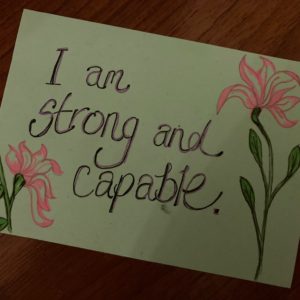
Having read the fantastic Tiny Habits by B.J. Fogg, I adopted the habit of saying my positive resolve out loud at the start of every day, the moment my feet touch the floor when I get out of bed (Fogg calls this ‘The Maui Habit’ – for a bitesize podcast description check out this link). Anchoring my practice to this action means I never forget to do it and that I start the day with positivity, setting the scene for how I respond to how the day unfolds. From a Yogic perspective, this repetition of your resolve as you transition from the sleeping state of consciousness to awakening is said by Dinsmore-Tuli to be a good way to imbue your Sankalpa with energy.
Deciding on your Sankalpa is a personal decision, but key tips for making a resolve are to keep it simple, express it positively in the present tense and ensure that it has personal resonance for you. You can also write out your positive resolve, being sure to leave it somewhere you’re likely to see it regularly. An example Sankalpa is shown here.
2 – The complete Yogic breath
The role of breathing in a holistic Yoga practice and the benefits of breath work need a separate blog post of their own, but suffice to say that working with your breath can have profound physical, mental and emotional effects. When stress and tension adversely affect our breathing pattern, our energy can be impacted because we are not as efficiently oxygenating our blood or clearing carbon dioxide. This practice, exploring the complete Yogic breath, can exercise the lungs, chest and diaphragm muscles, deepen the breath and bring more oxygen into the body. I find the complete breath a rejuvenating part of my morning routine, but it can be practiced at any time of day.
For this practice, I enjoy lying in semi-supine – knees bent, feet hip width apart – but you could also practice in Savasana (corpse pose), Tadasana (mountain pose) or seated as you prefer. This practice explores all parts of the complete breath, before putting them together. Staying for six breaths – saying to yourself ‘breathing in 1, breathing out 1, breathing in 2, breathing out 2 … – at each of the following is approximately a five-minute practice, depending on the length of your breath, so you may wish to set an alarm if you need to be sure of your time spent.
- Place the palms of your hands on your abdomen at the level of your navel, with your fingertips gently touching. With each inhale feel your navel rise, your fingertips gently parting; with each exhale feel your navel fall and your fingertips reconnecting.
- Place a hand on each side of your rib cage. As you inhale, feel it expand into your hands; as you exhale feel it contract.
- Place your hands palm down just underneath your collarbones, fingertips gently touching. Depending on your body geography and if it feels comfortable for you, your thumbs may come to rest in your armpits. Explore any sense of movement here as you inhale and exhale, perhaps visualising the air filling and then leaving your upper lung lobes with each breath.
- Finally place one palm on your navel and one palm on the heart space at the centre of your chest. As you breathe in, explore how your navel rises, rib cage expands, upper lung lobes fill; as you breathe out notice how your navel falls, rib cage contracts, upper lung lobes empty. Hook your awareness to the path of your breath through each of these places with each inhale and exhale.
Once you have finished, if in semi-supine, allow yourself to transition into Savasana and stay for three breaths before slowly rolling onto your side and coming to sitting/standing.
Remember to practice with curiosity towards your breath, not with force. If you lose count at any point, no matter, notice and restart your count, even if this means you don’t explore all parts of the practice. There is power in noticing the pull of your thoughts taking you away from your count and you may notice how some days this happens a lot more than others. If you fall asleep during the practice, that is probably what you needed more … for days like this be thankful for your timer!
3 – Mind the gap: taking a pause outside
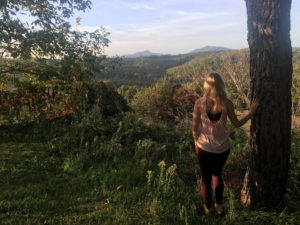 There’s so much to be said for the medicine of getting outside, for however short a time. At the moment more of us than ever have turned to walking whilst other pursuits are unavailable to us. But how present are you really to each step you take, or do you sometimes find yourself back home again without having noticed a thing?
There’s so much to be said for the medicine of getting outside, for however short a time. At the moment more of us than ever have turned to walking whilst other pursuits are unavailable to us. But how present are you really to each step you take, or do you sometimes find yourself back home again without having noticed a thing?
The subject of bringing mindfulness to your daily walk and the tradition of walking meditations is a rich one which I’ll return to in another blog. As a great starting point though, this five minute practice can start to bring us back to our senses, so we can be truly present, both with ourselves and our surroundings. I find this practice lessens anxiety, reconnects me to the earth and brings a sense of spaciousness and peace.
To practice, next time you’re outdoors, take five minutes to pause, bringing a gap to your day with these three steps:
Grounded – bring your awareness to the connection of your feet to the earth beneath you. What can you feel? If conditions allow, stand barefoot, although you may want to wait until summer to dispense with your shoes and socks! Notice all the contact points between your feet and the ground, the underside of your toes, the four ‘corners’ of your feet – big toe mounds, little toe mounds, inside and outside edges of your heels.
Aware – bring your awareness to all the sounds in your environment. Start with those closest to you, perhaps you’re aware of your breath, the rustle of the breeze in a nearby tree, and then gradually extend your awareness outwards and further away. Notice if your mind gets involved with any narrative about the sounds such as ‘I wonder what kind of bird that is, why don’t I know the sounds of more birds, isn’t it sad there aren’t as many birds around here as there used to be …’ and gently replace your attention onto the sounds themselves.
Present – bring your awareness slowly more inward by letting your attention return to the sounds closer and closer to you until you return to listening for the sound of your breath. Let this go and bring your attention to your heartbeat. If you can’t obviously hear or sense it, place your left hand on your heart or feel your pulse at your wrist. For the final moments of your practice, see if you can be present for every heartbeat or pulse, noticing when your mind wanders and gently returning it each time.
Again, you can set a timer for this practice and if you don’t have a deadline, you may find that five minutes becomes ten, but remember, if you only have two minutes you can still practice by shrinking each stage down. And if you’re not going for a walk that day, take your practice just outside your home, or even by an open window if you can’t get out. Any pause and conscious awareness you can bring to your day which also connects you with the outside is a good thing.
4 – Mindfulness meditation
It’s so wonderful to read and hear about more and more people discovering the benefits of meditation – improved focus, concentration and composure to name but a few. There are many fantastic apps out there with whole ranges of different meditations available for you to explore, but what I love about this particular practice is its simplicity – just you and your breath, available to you at any time, no device needed.
Sit on the floor – Sukhasana (cross-legged), Vajrasana (kneeling) – or on a chair with your spine erect (if you’re in Sukhasana you may wish to perch on a cushion or folded blanket to help with your hips being higher than your knees; if using a chair sit on the front edge of the seat away from the back support).
Place your palms on your thighs. Keeping your eyes open, bring a soft gaze to a point just over a metre in front of you. Keep it a soft gaze and allow yourself to be aware of your peripheral vision.
Now place your awareness on your breath, hooking your attention onto the path of each breath in and out. Notice any time your mind has wandered away and replace your awareness on your breath. Placement, noticing, replacement – it’s both that simple and that difficult. You’ll likely repeat this process many times during your five minute practice and that’s ok. The brain secretes thoughts – that’s what it does! Mindfulness meditation is about noticing this and practicing coming back to the present moment, over and over again.
5 – Moving the spine in all directions with this seated practice
Maintaining a healthy spine by moving it in all directions is a cornerstone of a well rounded asana (Yoga posture) practice. This five minute seated practice, (practice sheet available by clicking the link above), does just that; for me it also welcomes in feelings of openness and freedom, as well as being grounding, bringing me back into my body and out of my head with the connection of movement and breath.
Repeat the sequence three times for an approximately five minute practice (depending on the length of your breath).
N.B. remember to practice with kindness to the body – no gain from pain. If you require any modifications to this practice, please get in touch.
6 – Viparita karani (legs up the wall)
Are any of us getting enough rest these days? I know I’m currently not (occupational hazard of having a baby!), but I strongly suspect I’m not alone.
The time spent resting at the end of class can be considered one of the most important parts of our Yoga practice. According to Cyndi Lee, ‘the relaxation that comes from this time of letting go is more restorative than sleeping.’ Whilst I’m not suggesting that you substitute relaxation practice for sleep, spending five minutes in rest, letting go of ‘doing’ can be transformative in helping to bring some equilibrium to your day.
In the restorative practice of Viparita karani (legs up the wall), the wall is used to help your body relax into an inverted pose. Donna Farhi refers to this posture as ‘The Great Rejuvenator’ and I find it a really nice energy reset; especially enjoyable if you have been on your feet all day, or after particular periods of exertion.
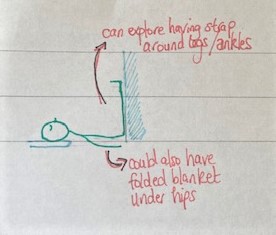
To get into position, sit with the side of your body as close to the wall as you can get and then rotate your body, walking your feet up the wall until you are in the pose. Don’t worry if your legs aren’t straight.
An important part of this posture is to get really comfortable, so that you can settle into stillness for the time you have available to stay there. So it is worth experimenting with various props to see what best works for you. For example, you may want a folded blanket under your hips or head or both, whilst securing a Yoga strap (if you don’t have one a tie or dressing gown belt will do the same job) around your legs can allow a further release from the effort of keeping your legs together.
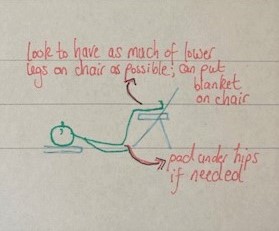
If you are finding that having your legs up the wall isn’t working for you, give this variation with a chair a go.
A non-essential, but really lovely, addition to either of these variations is the placement of an eye pillow. For me this just seals the pose, helping me to more easily go inwards and switch off. I particularly love this lavender filled eye pillow from the ethical Yoga shop YogaClicks for something extra calming and soothing.
Like anything, the ability to let go and not do anything at all will improve with practice, so don’t be disheartened if you find that your mind is very active. Alternatively you may find you fall asleep in the pose, having not realised how tired you actually are. Both of these scenarios help you find out something about yourself, that you wouldn’t have known if you hadn’t laid down to practice. As Cyndi Lee says, ‘this information is a very important step toward experiencing balance in your life.’
N.B. if any of the following apply to you, take your rest in Savasana (corpse pose) instead and/or drop me a line so I can help advise further: hiatal hernia, eye conditions, heart or neck problems, high blood pressure, menstruation. If in the second or third trimester of pregnancy, take rest in side-lying Savasana (on your left side) – again drop me a line for extra advice.
7 – Gratitude journaling
The yamas and niyamas are two of the eight limbs of Yoga; together they can be thought of as principles which when followed help us to live peacefully and soulfully.
One of the niyamas is santosha, the practice of contentment. For me, writing down what I’m grateful for each day is one way that really helps me to nurture a sense of santosha.
 Like meditation, it feels like gratitude journaling is increasingly referenced at the moment and there’s plenty of reasons why people are finding value in this practice. As neuropsychologist Rick Hanson writes in the great little book ‘Just One Thing’, not only is there research linking the practice of gratitude to improved well-being, better coping and even improved sleep, but it also helps us feel ‘fuller and fuller, more and more fed by life instead of drained by it’, in turn meaning that ‘you naturally feel like you have more of value inside yourself and more to offer others.’
Like meditation, it feels like gratitude journaling is increasingly referenced at the moment and there’s plenty of reasons why people are finding value in this practice. As neuropsychologist Rick Hanson writes in the great little book ‘Just One Thing’, not only is there research linking the practice of gratitude to improved well-being, better coping and even improved sleep, but it also helps us feel ‘fuller and fuller, more and more fed by life instead of drained by it’, in turn meaning that ‘you naturally feel like you have more of value inside yourself and more to offer others.’
For this practice, choose a time that will work best for you each day to take five minutes to list things you are grateful for. For example, you might commit to ‘after I’ve got changed for bed, I’ll write my gratitude list’. Leave a pen and journal in the place that connects to the time of day you choose, so in this example, on your bedside table.
What you write on your list can be big or small, for example ‘my health’, ‘the sound of birds singing’, ‘the food I’ve eaten today’. What I find is that as you work at this practice daily, it slowly becomes easier and easier as your mindset shifts to more readily noticing the good in each day – even those days that are more challenging than others.
Celebrating your practice
I really hope you enjoy making a habit of adding in some self-care to each of your days and notice the difference it makes to your well-being. All of these practices can be shrunk down to less than five minutes if needed – the important part is to start. Committing to two minutes each day can be enough to sow the seeds for regular practice. Once it becomes a daily habit you may find two minutes becomes five which becomes ten …
When you practice, check in with how you feel – is it different to how you felt before the practice? Consciously connecting with positive feelings from practicing can help to anchor the habit as a routine part of your day, along with acknowledging your achievement with a small celebration – yes! Go you! And as day by day you practice, remember the wonderful ripple effect of self-care; how taking care of ourselves better helps us care for others. As Nadia Narain and Katia Narain Phillips say in their beautiful book, ‘Self-care for the real world’:
‘… right now you may be deep in the waves of life, being tossed around. Learning self-care is like building your own lifeboat, plank by plank; once you’ve got your boat, you’ll still be rocked by the same waves, but you’ll have a feeling of safety, and a stability that means you can pick up other people on your way.’
© Catherine Rolfe Hatha Yoga Teacher 2021
Thank you for dropping by this blog, I hope at least one of the practices is a good fit for you. Why not explore one of them right now? Please drop me a comment below for any questions or feedback – I would love to know how you get on.

If you’d like to read more around the sources of inspiration for these practices, and the resources referenced in this blog, do check out the clickable links above, as well as the books shown here. I’m grateful to all of these wonderful teachers and authors, putting what they have learned out into the world for us all to benefit from.
Also thank you to Padraig O’Morain’s Daily Bell for the Anthony de Mello quote. If you’d like Padraig’s daily dose of mindfulness delivered to your email inbox, you can find out more by clicking here.
